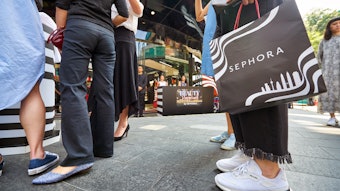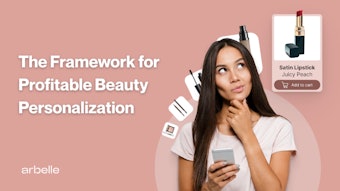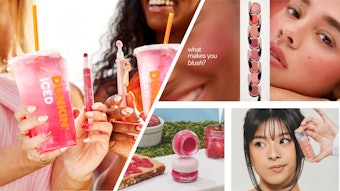From the GCI archives.
As usual, sun care, baby care and the men’s toiletries part of men’s grooming were extremely dynamic.
With global sales topping $253 billion, cosmetics and toiletries (C&T) is on the rise after a lackluster 2004, according to Euromonitor International’s 2005 research. Although growth in Western Europe, the largest market, has almost peaked, recovery from economic uncertainty and the threat of SARS in North America and Asia Pacific respectively brightened the picture for developed regions. When combined with strong performance from the darlings of the industry—Latin America and Eastern Europe—the outlook for C&T is significantly rosier, registering almost 5% growth over 2004. This feature reviews region and sector development over the past year, comments on key trends and speculates as to future direction to ensure that forecast growth of 20% to 2010 is attained.
Mature Markets Mixed
Western Europe continues to take the lion’s share of global C&T sales—although its importance has contracted over the years. The region now accounts for 30% of the world market, with sales valued at $76.4 billion last year, up 2.6% compared with 2004. Taking a closer look at the European big five reveals that France, Spain and Italy saw their growth slow last year—the former two having historically proven fairly resilient to the woes that have befallen other key Western European countries. Germany saw sales decline by just 0.6%. Although this is positive when compared to the drop of -1.4 % last year, the general mood and willingness to buy remains low. With the strength of the discounter trend impacting development, cut-price private labels are bound to fare well.
North America, valued at $54 billion, accounts for 21% of global sales. The 3.3% increase in sales on 2004 is the best growth the region has achieved since 2001. This is clearly due in no small part to the United States, which accounts for 90% of the region’s sales. The U.S. continued to post positive economic results in 2005, with GDP growth of 3.5%. Consumer demand for cosmetics and toiletries, as well as goods and services in general, has stayed strong despite rising energy prices and interest rates.
Asia Pacific Cashes In
Second-place Asia-Pacific scored sales of $63 billion, an increase of 5%. Japan accounts for just over 50% of this region’s sales with growth of 2.9% last year, representing the strongest increase this country has seen for many years. It is China, however, that contributed the most to the region’s growth. Dynamism in China is not new, with European and American multinationals acquiring Chinese companies and brands for many years to enable them to benefit from high forecast growth. China’s status as a priority market was reaffirmed in 2005, with major players, including Estée Lauder (introduced both MAC and Bobbi Brown) and P&G (introduced Max Factor), increasing brand portfolios there.
Retailers, including C&T specialists Sephora and Sa Sa, also have their eyes on China with new store announcements on a frequent basis; direct sellers such as Avon, Alticor, Mary Kay and New Skin are salivating at the potential to benefit from the Chinese government’s December 2005 decision to lift restrictions prohibiting sales agents that are not attached to stand-alone stores. All of these factors are likely to unite to enable manufacturers to push C&T out of the primary economic zones to the majority of the population, creating a massive sales boost.
Brazilian Beauty Blossoms
Latin America was the fastest-growing area last year, with sales up 11.3% to $28 billion, with all countries posting good gains. Brazil, in particular, has boosted the region’s sales with significant acceleration since 2001. Looking forward to 2010, the country will remain Latin America’s most attractive market—both in terms of growth and value sales gains. Huge future potential make it a honey pot for new entrants keen to take advantage of both increased domestic demand and the rising popularity of Brazilian products in developed regions. The addition of natural ingredients, as diverse as obscure Amazonian fruits and extracts of shark fin, has been a key trend in Brazilian new product development since 2001. In opening a Paris store last year, Natura Cosméticos SA, Brazil’s leading direct sales player in C&T, is attempting to capitalize on the preference for natural products in Western markets.
Companies planning to conquer the Brazilian market should heed this advice: The greatest rises are expected in fragrances, hair care and premium quality product offerings as consumers trade up in line with their growing incomes. With a majority of the population earning between BRL7,000 and BRL14,500 ($2,500 to $5,000) per month, manufacturers should target the masstige price category to maximize profitability from the country’s strong growth forecasts. However, consumers in the lower income brackets should not be ignored, with the development of cheaper product ranges for the discount market a sure-fire way to reap rewards.
Skin Care Reigns
Skin care is the largest sector in global C&T, and, in contrast to the second and third largest (hair care and color cosmetics), it maintains very strong growth rates with sales up 6.8%. Although facial skin care presents the biggest prizes, 2005 has seen manufacturers such as L’Oréal and P&G (with its Olay brand) extend their facial brands to other parts of the body. Firming/anti-cellulite body care enjoyed growth of approximately 9.5% in 2005, making it the world’s most dynamic skin care sector and demonstrating a growing consumer preoccupation with body-focused skin care. In June 2005, LVMH’s Benefit brand became body conscious, launching its Wonderbod collection. This February, Beiersdorf subsidiary Juvena introduced Juvedical Renewing Body Serum and Renewing Body Cream as part of its attempts to offer products suitable for the whole body.
Other factors fueling skin care’s growth in 2005 are the continued pre-occupation with anti-aging products, which has prompted the launch of advanced formulas from mass players (Olay’s Regeneriste, Avon’s Anew and L’Oréal’s DermoExpertise) and super-premium products from doctor brands. Men’s skin care also has been a strong performer, and potential in areas such as Eastern Europe indicate that key players in this space should begin to think about global expansion.
Segment Ailing Sectors
As usual, sun care, baby care and men’s toiletries were extremely dynamic. Africa/Middle East and Eastern Europe have been particularly significant for men’s and baby, while global sun care growth has been helped by Asia-Pacific and Latin America. All three product areas still offer up plenty of growth potential in developed markets. Sectors such as hair care, bath and shower, and oral hygiene all have been relatively slow moving since 2001 due to their high penetration. However, there is potential to eke out growth by slicing and dicing consumers into microsegments, as exemplified by hair care. There now are products for men, women and children; those for hair that is oily, curly, dandruff-prone and even straight (Garnier Fructis Long and Strong), and lines to give treatment benefits (antiaging and antipollution for example), indicating that innovation is key in mature sectors. Manufacturers that want to revive other struggling sectors can employ such a strategy.
Bigger and … Bigger
Besides heralding recovery, Euromonitor International’s data illustrates that merger and acquisition activity has shifted the landscape of the global C&T industry. The industry’s largest acquisition to date was Procter & Gamble’s takeover of Gillette for $57 billion in January 2005. This has had a huge impact on the C&T ranking, knocking L’Oréal from its number one spot in the industry. Other merger and acquisition activities saw Kao buy both Molton Brown and Kanebo. Coty signed a deal to acquire Unilever’s fragrances division, and the flurry does not look set to waver following L’Oréal’s acquisition of The Body Shop in February 2006, a move perceived as an attempt to fight back against the new superpower of personal care as well as to tap into the naturals trend.
Year of Megabrands
Megabrand was the word on everyone’s lips in 2005, with major players such as Shiseido, Avon, Unilever and Procter & Gamble focusing innovation on a handful of high-impact brands. The trend continues in 2006. Brands have been split into new categories and even extended into different sectors to scoop up sales and broaden appeal among a wider consumer base.
The year saw a number of skin care brands reach out into hair care. In April, Accantia launched a new range of perfume- and color-free hair care products under its leading Simple brand. In the same month, Estée Lauder levered its Clinique brand into the sector with the launch of True. Tapping into the ethnic category will help extend other big brands across a range of sectors. In September, Unilever filed a trademark for Sunsilk Anti-Sponge shampoo, suggesting that an ethnic hair care launch is on the cards for the Sunsilk brand; via the megabrand, manufacturers can milk broader industry trends and target new lucrative groups such as ethnics, teens, ’tweens and grays while reinforcing brand equity.
Celebrity Cosmetic Star
Arguably, 2005 has cemented the most effective cosmetics and toiletries advertising technique of all time—that of the celebrity endorsement. Film stars, musicians and sports heroes have been backing beauty launches for decades. The move has proven so powerful that manufacturers, notably Coty and Elizabeth Arden, have begun using the famous to brand their products. Celebrity labels are most heavily concentrated in the fragrance sector—with Hilary Duff, Sarah Jessica Parker and Danielle Steel among the long list of stars who have put their names to scents in 2005. And so far, the strategy is paying dividends. Coty’s Glow by J-Lo has been the world’s most dynamic premium women’s fragrance since 2001.
However, manufacturers need to recognize the potential backlash that this strategy could unleash. Indeed, via such campaigns as Dove’s “Real Beauty,” a rise in self-esteem marketing is being seen. Unilever says sales of Dove’s skin firming range ballooned by 700% worldwide as a result. Encouraging women to feel comfortable in their own skin, Unilever positions Dove as a way for consumers to enhance their own unique beauty rather than squeeze into an unrealistic mold—an attempt to create a new mechanism for generating feelings of loyalty and trust. The market is seeing a rise in customized labels, promoting the idea that every consumer is a star. Recent launches include L’Oréal’s True Match foundation with opti-match technology and Estée Lauder’s customizable eye shadows and blusher. Manufacturers looking to stand out in 2006 could do well to ditch the celebrity and focus on the real beauties instead.
Organic C&T Dawns
As trends in food transfer into the personal care industry, consumer awareness of health risks rise and a general shift toward more holistic health and beauty continues, an increased demand for natural and organic C&T products is evident in 2005. Currently, organic C&T products—subject to different levels of certification depending on their country of origin—are the preserve of niche players such as Jason Natural Products, Burt’s Bees and Green People, with launches of private label ranges expected in 2006. However, mainstream companies definitely are embracing the naturals trend that parallels organic but is subject to much less rigid scrutiny, as governing bodies have yet to arrive at a standard definition of the term. Key sectors for natural products include baby care (as such products are perceived as inherently safer) and bath and shower, as manufacturers exploit this trend to increase prices and drive growth. Food ingredients (such as milk, honey and olives) and time-proven favorites including cocoa butter and aloe are an easy way to get into the game. In 2005, many C&T multinationals attempted to take advantage of consumer ignorance by using natural or herbal in their marketing when, in reality, the products are anything but. As consumers become increasingly savvy, this tactic could start to fall flat on its face, and is likely to become subject to regulation in the not-so-distant future.
Future Growth Forecast
Euromonitor International forecasts average annual growth of 3.7% to reach global sales of more than $300 billion by 2010. Skin care and sun care are expected to lead growth, with emerging markets Russia, China and Brazil increasing dramatically in terms of importance (watch for India to join this group). As these areas grow, it is likely that local leaders such as Natura, Kalina and Faberlic will become increasingly important on a global scale, as seen with South Korean player Missha in 2005.
In terms of trends, the megabrand looks set to stay for the near future as companies such as Shiseido include this in their core strategy. Since the finalization of L’Oréal’s acquisition of The Body Shop, Colgate-Palmolive purchased Tom’s of Maine, a natural personal care company, indicating that larger manufacturers are targeting niche players to give them a foothold in segments with growth potential. Whatever the future holds, innovation will be a key to success, and manufacturers and retailer alike will have to adapt to the changing circumstances rapidly to exploit growth potential.
For additional cosmetics and toiletries market reports, visit www.euromonitor.com/cosmetics.










